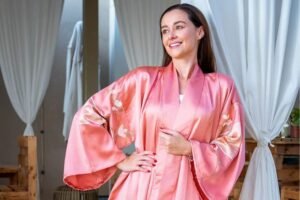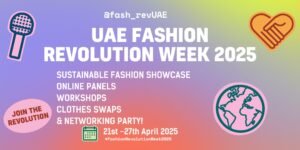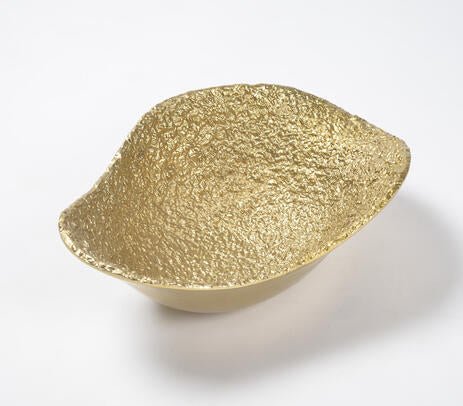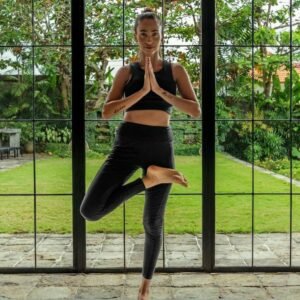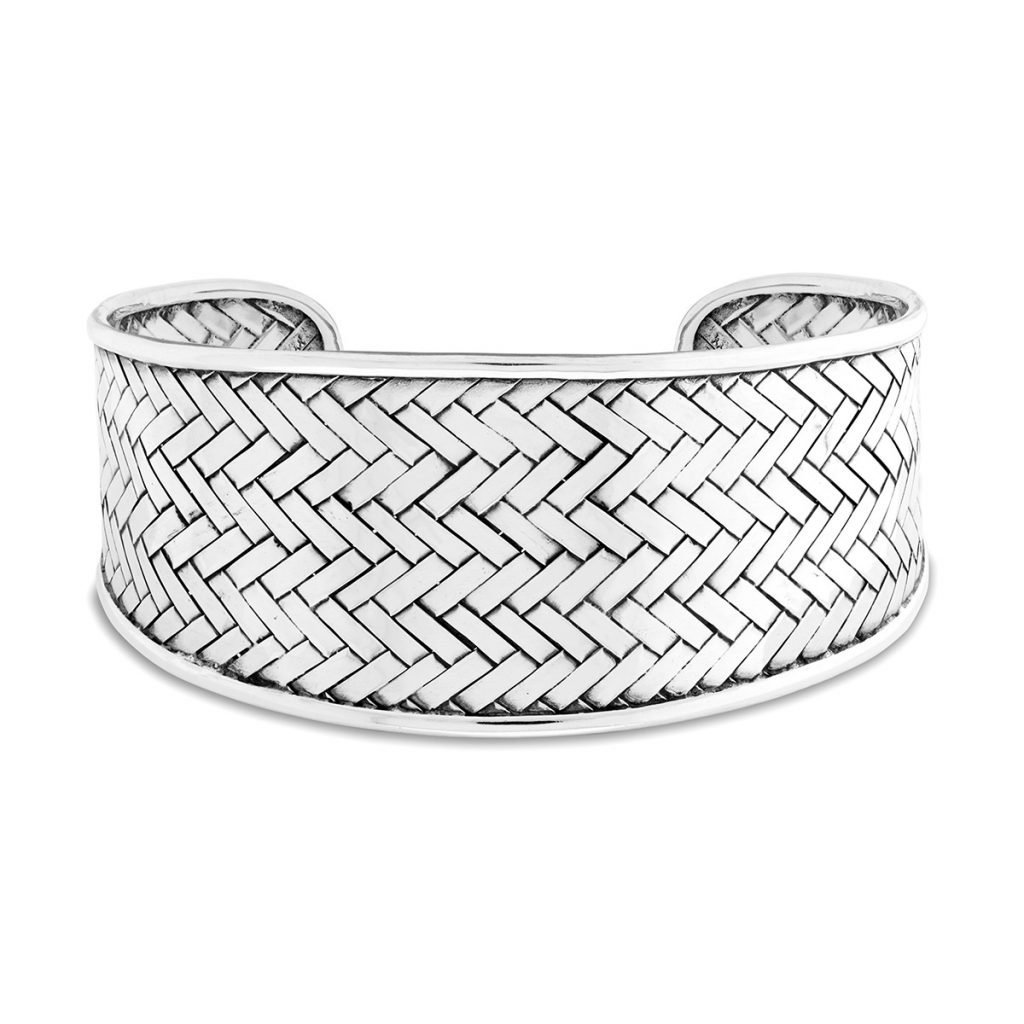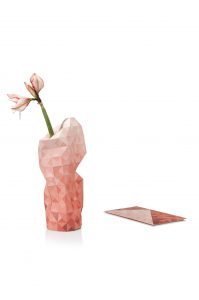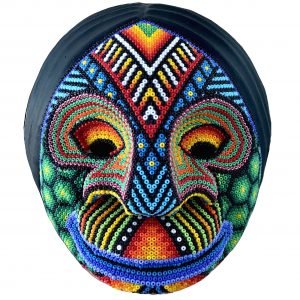We know how overwhelming and confusing it can be certain terminology. In sustainability, we have also our own slang and sometimes it needs a bit of explanation. That is the reason why we have put together this glossary or minidictionary about sustainable fashion terms. If you are missing any word, send us an email and with pleasure, we will add it to the list.
ABC OF SUSTAINABLE FASHION TERMS
A
Artisan is a skilled craft worker who makes or creates material objects partly or entirely by hand. When possible, look for clothes made by craftspeople and artisans. This supports their traditional and artisanal expertise, skills and processes to preserve their cultural heritage. Be aware of cultural appropriation (or misappropriation) – this is the adoption of elements of one culture by members of another culture.
B
Biodegradable means that a product can break down naturally without any negative effects on the environment, such as releasing harmful chemicals. In the fashion industry, biodegradable often refers to non-synthetic fabrics and those without dyes and finishing chemicals. This is the case of all the products of Eli´s Boots. All are 100% biodegradable vegetable-tanned camel leather. And remember you can enjoy Free International Shipping in all our fashion products.
Biodiversity is the variety of life on earth. It comprises variability within species, among species, and of ecosystems. It also refers to the complex relationships among living things, and between living things and their environment.
C
Carbon-Neutral
Carbon is shorthand for all the various greenhouse gases — carbon dioxide, methane, and nitrous oxide. These gases absorb and emit radiant energy that increases the temperature of the earth’s surface and therefore contributes to climate change. A company striving for carbon neutrality means they are aiming to eliminate all carbon emissions from its supply chain.
Child labor is often defined as work that deprives children of their childhood, their potential, and their dignity, and that is harmful to physical and mental development.
Circular fashion /economy refers to the entire lifecycle of a product and centers on a circle of “create, use, recycle”, rather than the linear “create, use, dispose”. It looks at products beyond their original function and timespan and focuses on how their materials can be consistently utilized and repurposed. Circular fashion takes into consideration everything including the design, sourcing, transportation, storage, marketing, sale and disposal of the product.
Circularity is the approach to designing and producing products that can be repaired remade, reused, and eventually recycled or biodegraded at the end of its use. Truly circular products must be non-toxic, preferably biodegradable so that any waste generated is minimized. Given the fashion industry’s massive waste problem, circularity is currently very trendy with brands having started recycling programs and ‘take-back’ schemes. Check this video from the Ellen McArthur Foundation to see it visually.
Collective bargaining is a process where employers and unions negotiate to determine fair wages and working conditions.
Conscious fashion is a bit of a catch-all term. It is often used synonymously with “ethical”, “sustainable” or “eco” fashion. Some brands use the name to imply “mindful” and “purposeful”. They don’t always have to be a sustainable fashion brand, though some may be. It is best to check for more information if that is something that is of real importance to you.
Conscious consumer is a person that decides to consume consciously, taking the time to reflect on the impact of their choices, and trying to minimize it. Conscious consumerism is opposed to mindless consumerism.
Compliance means that companies are adhering to the law. This might not always be good enough, as labor laws in foreign countries are weak.
Cost-per-wear considers the value of a piece in relation to how many times it’s worn. For example, you buy a pair of $200 sneakers and wear them twice, that’s $100 per wear. You wear them 100 times, its $2 per wear, and so on. Think of items less as objects but more in terms of use. It’s much better to spend more on a pair of jeans you can practically live in for the next few decades than a cheap $30 pair that fall apart in under a year.
Closed-loop cycle is a common term and its very similar to circular fashion. In fashion, it means that new clothes are made from preexisting clothes and textiles. Once an item has reached the end of its lifecycle, it can be broken down, turned back into yarn/fabric and then recycled into another garment. This forms a “closed-loop” in that an item would have an eternal life cycle and therefore eliminate waste.
Craftsmanship refers to fabrics and accessories developed with traditional artisanal techniques that preserve local know-how and heritage and their transmission across generations. A good example is the raffia embroidery technique below. Thanks to Verbena Madrid this traditional technique is seeing a new renaissance.
Cruelty-free means that companies did not test ingredients or products on animals during the production phase. Items that meet this standard normally carry a heart symbol. Cruelty-free in fashion means that no animals were killed or harmed. This applies in the process of manufacture of both the material and the product. Cruelty-free on beauty products means the finished product wasn’t tested on animals. If you want an item that is free of animal byproducts in regards to beauty, you need to look for a vegan product. Take into account that it doesn’t necessarily mean the manufacturing process of the item is cruelty-free for humans.
Check some of the vegan products of Goshopia below. Cruelty-free for animals and for people. ❤
-
 Amy Black Trousers$130.70
Amy Black Trousers$130.70- AED: 480.00AED
- GBP: $96.80
- AUD: $203.16
- KWD: $40.230
- EUR: €115.59
- CAD: $180.58
- OMR: $50.083
- QAR: $473.38
- SAR: $487.82
- SGD: $168.26
- ZAR: $2,340.38
In Stock
D
Deadstock fabrics are textiles that are no longer useful for big factories or companies. There various reasons for deadstock fabrics. Sometimes the textiles no longer fit for the company´s designs. Sometimes there is an overstock of that particular design, the rolls might have slight damages, didn’t meet the initial color matching, or the simply the color is no longer in season. Whatever the reason, those rolls are already there and are beautiful pieces that we can give a second chance. Some of our designers at Goshopia love the fabric treasure hunt. For them, these vintage fabrics have a journey worth sharing. It makes the garments limited edition and very special. The idea behind is maximizing the lifecycle of the existing fabrics.
Essa, for example, did a gorgeous Japanese collection out of end of rolls and deadstock fabric. Lovely, isn’t it?
-
 Ichigo Dress$476.50
Ichigo Dress$476.50- AED: 1,750.00AED
- GBP: $352.91
- AUD: $740.69
- KWD: $146.673
- EUR: €421.42
- CAD: $658.35
- OMR: $182.595
- QAR: $1,725.85
- SAR: $1,778.52
- SGD: $613.45
- ZAR: $8,532.65
In Stock Made to Order
-
 Dragon Temple Dress$299.52
Dragon Temple Dress$299.52- AED: 1,100.00AED
- GBP: $221.83
- AUD: $465.57
- KWD: $92.194
- EUR: €264.89
- CAD: $413.82
- OMR: $114.774
- QAR: $1,084.82
- SAR: $1,117.93
- SGD: $385.59
- ZAR: $5,363.38
In Stock Made to Order
-
 Rabbit and the Moon Pink Dress$299.52
Rabbit and the Moon Pink Dress$299.52- AED: 1,100.00AED
- GBP: $221.83
- AUD: $465.57
- KWD: $92.194
- EUR: €264.89
- CAD: $413.82
- OMR: $114.774
- QAR: $1,084.82
- SAR: $1,117.93
- SGD: $385.59
- ZAR: $5,363.38
In Stock Made to Order
Decent Work involves opportunities for work that is productive and delivers a fair income, security in the workplace and social protection for families. It also brings better prospects for personal development and social integration, freedom for people to express their concerns, organize and participate in the decisions that affect their lives and equality of opportunity and treatment for all women and men.
Due diligence is a process through which companies assess their impacts on human rights and the environment and then take actions to reduce any negative impacts.
E
Eco-friendly fashion, like sustainability, is an all-encompassing term that takes many factors into account. “Eco” is short for ecology, the study of the interaction between organisms and the environment. Therefore, eco-friendly is about minimizing anything that would negatively affect that balance. Things to consider include what material a product is made from, such as organic cotton or hemp, whether it is dyed with organic dye or chemicals and how much water is used to grow the fabric.
Environmental impact refers to the direct effect of socio-economic activities on the environment.
Equal pay means that men and women in the same employment performing equal work must receive equal remuneration. This applies not only to salary but to all contractual terms and conditions of employment, such as holiday entitlement, bonuses, pay and reward schemes, pension payments and other benefits.
Ethical Fashion usually refers to the treatment of people and focuses on the social impact of the fashion industry. Creating goods that positively impact the lives of those making them, reducing poverty through non-exploitative employment. Ethical fashion covers a wide range of issues such as living wages, working conditions, health and safety, forced labor, child labor. It means going beyond simply following local labor laws that in some producing country are far beyond par. Some also use the term “ethical” to refer to cruelty-free products. Terms such as “ethical leather” and “faux fur” aren’t always ethical for the humans that produce them and often these products do not biodegrade easily either.
As an example, I always share the story of Vino Supraja. She went to India and sat down with the weavers of her collection for close to 3 months. Making sure they were happy and she was able to understand their struggles and their needs. The collection speaks loud about quality and design as it is full of art deco references with a twist. But the most beautiful part of it is the individual happiness stories they represent. This is the kind of fashion we need!
F
Fast Fashion is an approach to designing, creating, and producing products based on fast-moving trends and cheap prices. These brands have perfected bringing runway knockoffs to stores at affordable prices. While cheap and trendy, fast fashion is dangerous because it results in overproduction, waste, environmental degradation, and the overworking of factory makers. Fast Fashion pioneers include H&M, Zara and TopShop, although super Fast Fashion brands have been emerging, such as Fashion Nova, Zaful, Missguided, and Boohoo.
Fair Trade Fashion provides an alternative to conventional trade. Fair trade products charge a premium to consumers so that producers (such as farmers) can earn a better living. While fair trade is a step in the right direction, it is not the same as living wages. Moreover, fair trade in fashion is more complicated than food because the fashion supply chain is more fragmented. For example, the cotton may be fair trade, but the factories where the clothes are cut and stitched may not. Insist on fair salaries and safe working conditions for every person involved in the creation of the clothes you wear. From field to final. From the sourcing of raw materials to the garment factory to the shop floor.
The Fairtrade Mark is a signifier for products that meet internationally agreed social, environmental, and economic Fairtrade Standards in the last few years. Profits made from products that qualify for the Fairtrade Mark go towards supporting farmers and workers, and improving lives and communities. Fairtrade Cotton has its own mark as does Fairtrade Textile Production, and these symbols are good indications of how ethically sound a garment is.
Fashion Revolution is a global movement that believes in a fashion industry that values people, the environment, creativity and profit in equal measure. It was born on 24th April 2013, when the Rana Plaza factory collapsed, killing 1138 people and injuring many more. Fashion Revolution launched its Fashion Revolution Week, which happens every April and promotes their #whomademyclothes campaign. During this week, consumers ask brands #whomademyclothes, to promote transparency in the fashion supply chain.
Freedom of Association is the right of individuals and workers to form and join groups of their own choosing in order to take collective action to pursue the interest of the members of the group.
Forced labor refers to situations in which persons are coerced to work through the use of violence or intimidation. There are other more subtle means such as accumulated debt, retention of identity papers or threats of denunciation to immigration authorities.
FSC-certified means that the fabric is made from tree fibers that come from sustainable sources and that they do not originate from endangered or ancient forests. Rather, the fibers here come from well-managed forests and large scale areas of conservation. Tencel and Monocel products, for example, often come from FSC-certified eucalyptus and bamboo respectively.
G
Gender-based violence is violence directed against a person because of their gender. Both women and men experience gender-based violence but the majority of victims are women and girls. Gender-based violence that results in, or is likely to result in, physical, sexual or mental harm or suffering to women. These include threats, coercion or arbitrary deprivation of liberty, whether occurring in public or in private life.
Gender equality refers to the equal rights, responsibilities, and opportunities of women and men. Equality does not mean that women and men will become the same. It means that women’s and men’s rights, responsibilities and opportunities will not depend on whether they are born male or female.
Greenhouse gas (GHG) emissions refer to the release of greenhouse gases (GHG), into the atmosphere. GHGs, such as CO2 and Methane, are any gases that absorb and re-emit heat and therefore keep the planet’s atmosphere warmer than it otherwise would be.
Goshopia is the pioneer in the Middle East when it comes to sustainable fashion. An e-marketplace offering a curated selection of designers and brands that follow at least one of their 3 S´s or core values: Slow Fashion, Sustainable Fashion, and Socially responsible brands and projects.
GOTS certified means that the item or the fabric has been certified by the Global Organic Textile Standard (GOTS). This German standard is one of the most difficult to obtain. It reviews the organic status of textiles from harvesting of the raw materials through environmentally and socially responsible manufacturing all the way to labeling. It is recognized worldwide and helps provide credible assurance to the consumer.
Greenwashing is the practice of branding or marketing a product in a way that misleads the consumer about its social and environmental benefits. Companies usually market supposedly “environmentally-friendly” initiatives, like using recycled packaging, becoming a paperless office or “conscious” collections, while not addressing critical environmental and labor issues. An example of greenwashing is a brand claiming that a dress is eco-friendly because it’s made of eco wool. When checking the label, in fact, it contains just 4% eco wool, along with other less sustainable materials. Another example would be a brand loudly advertising a collection of 20 sustainable pieces while its inventory contains thousands of garments that aren’t sustainable. Unfortunately, most big fast-fashion brands claiming sustainability credentials are guilty of greenwashing.
L
Limited Edition collection is a collection that for some reason limits their number of pieces produced. It might be for some marketing or strategic reason but also due to, for example, the use of deadstock fabric or end of rolls.
A living wage is a minimum wage or income necessary for a worker to live a decent life. It has to meet their family’s basic needs – including food, housing, clothing, education, and healthcare. It’s different from the legal minimum wage. It depends on each country’s standard of living.
M
Made to order or Custom-made is produced to supply a special or an individual demand. It´s ideally suited to a particular purpose, person sizing and needs. For example tailoring services. It´s very much aligned with the Ultra Slow fashion, where the item is produced once the order is placed.
Material sourcing is the process of determining how and from where manufactured goods or components will be procured. When possible, look for clothes made from environmentally-friendly raw materials such as bamboo, hemp or organic cotton. Garments made from one fiber can be recycled more easily. Deadstock can be turned into limited-edition collections.
Microplastics are plastic pieces that are less than 5 mm in length. There are two sources; primary and secondary. Primary sources are microplastics that have been made to be that size. For example, microbeads in cosmetics or plastic glitter. Secondary microplastic comes from larger items of plastic that have fragmented. For example, plastic pieces fragmented from a polyethylene carrier bag. Our synthetic clothes release quite some microfabrics when washed. One solution can be the Cora Ball.
Minimalism is about reducing the amount of stuff that you own. It’s not about having nothing; it’s about having less. Focusing on what matters by decluttering and removing what’s burdening us. It can mean having a minimal amount of clothes in your wardrobe but not necessarily. Minimalism also applies to your style. Having straightforward, essential, often monochromatic pieces, so your style is as streamlined as possible. Minimalism has become popular recently thanks to Netflix´s series with Marie Kondo and The Minimalists.
Monoculture or Monocropping are terms related to organic farming. According to World Atlas, monoculture refers to the agricultural practice of cultivating a single species of crop or animal. It’s predominately a large-scale production technique, allowing for specialization, efficiency, and simplification. Such as cotton. However, it comes with side-effects. In a varied cultivation set-up, each plant contributes to that particular environment, keeping the nutrients in the soil balanced and replenished. The growth of only one crop has a negative effect on the texture of the soil due to the lack of varied bacteria. This will lead to more contamination, which leads to the use of more pesticides, fertilizers, and ultimately more water usage.
Mulesing. While wool, if free of synthetic blends, is technically biodegradable, it doesn’t necessarily mean that the sheep it comes from were treated well. PETA has documented horrific cases of sheep mistreatment in Australia. The country produces much of the world’s merino wool but also uses a grim procedure called “mulesing”. Basically they flesh from a sheep’s buttock’s to prevent flystrike. Flystrike is some flies that would lay eggs on the animal. They will grow into maggots and eventually eat the flesh. That sounds ok, they do it without any anesthetic.
N
O
Ocean waste or marine debris, as Ocean Service explains, is “persistent solid material (such as plastic) that is disposed of into the marine environment.” Not only ocean waste injures and kills marine life. It also causes potential navigation and safety risks, and poses a threat to human health”.
Organic is a term we see a lot in the food industry, but it also applies to fashion. It refers to raw materials that are not genetically modified (GM) and have been grown without the use of chemical fertilizers, pesticides, sewage sludge, ionizing radiation or other artificial ways. The term ‘organic’ generally has a positive context, but just because a product is organic does not make it ethical. For example, organic cotton could have still be picked by a child. Organic also doesn’t account for added toxins such as dyes. These chemicals can be harmful to the planet, the people that produce the plants and the consumer who wears the final product. Several organizations, such as the Global Organic Textile Standard (GOTS) and the Better Cotton Initiative (BCI) are helping consumers find certified organic items.
Organic Cotton. Cotton is probably the most common organic fiber you can buy. Organic cotton has come under criticism, however, because it requires a lot more water and irrigation than conventional cotton. However, pesticides that go into conventional cotton wreak havoc on the environment, as well as the health of humans who drink from water supplies nearby. The solution isn’t to discount organic cotton, it’s for all of us to consume less cotton in general.
-
 Blue Cotton Silk Cocktail Dress$243.70
Blue Cotton Silk Cocktail Dress$243.70- AED: 895.00AED
- GBP: $180.49
- AUD: $378.81
- KWD: $75.013
- EUR: €215.52
- CAD: $336.70
- OMR: $93.384
- QAR: $882.65
- SAR: $909.59
- SGD: $313.73
- ZAR: $4,363.84
In Stock
-
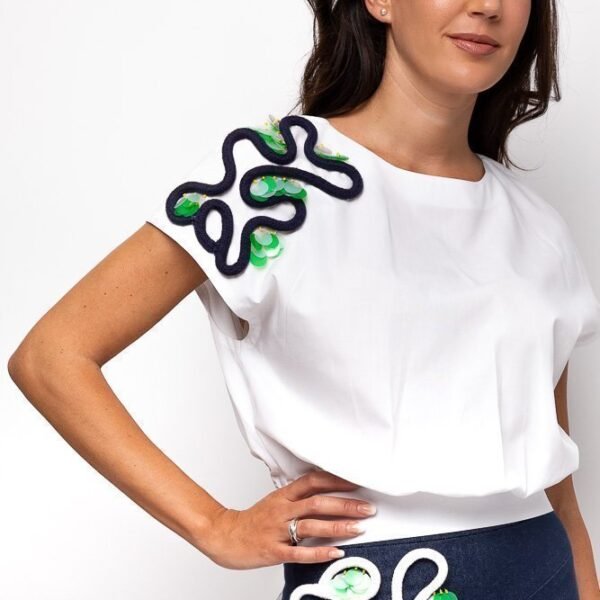 White Cotton Top with a Sea Splash$148.67
White Cotton Top with a Sea Splash$148.67- AED: 546.00AED
- GBP: $110.11
- AUD: $231.09
- KWD: $45.762
- EUR: €131.48
- CAD: $205.41
- OMR: $56.970
- QAR: $538.47
- SAR: $554.90
- SGD: $191.39
- ZAR: $2,662.19
In Stock
P
Pre- and Post-Consumer Waste. As Research Gate explains, pre-consumer waste refers to manufacturing waste. Post-consumer waste is what’s collected after the owner has disposed of it. But we love the quote that says “waste isn’t waste until we decide it is”. For more great fashion quotes, check this other article.
Q
Quality is how good something is. If the quality of an item is low that means that the product may break easily or not work properly. Usually, higher-quality products cost more money, because the materials used to make them are better, or the way they were made was more effective. It is the basis for sustainability as the products need to last longer.
R
Recycling is the action of converting waste into something reusable. For example, some brands have turned plastic bottles into yarn to make fleece sweaters or coats. We can recycle garments to reduce waste and landfill. But be aware as sometimes a production process involving recycled clothes and materials uses more energy and chemicals than making new garments.
Reduce definition is make smaller or less in amount, degree, or size. It is part of the R´s in sustainability. It refers to reduce our consumption, the emission of Greenhouse gases, etc..
Reuse means use again or more than once. We should consume thinking of how we will be using and reusing our products until their lifecycle end. In fashion, we can give a second life to garments we no longer use by donating them or reselling them. It is another of the R´s in sustainability.
Refuse or Reject is another of the R´s of Sustainability. It refers to refuse items that dont follow our values or our criteria. Same as you can refuse to use plastic straws, you might want to refuse to use polyester in your clothes.
Repair or restore to a good condition is one of the bases of sustainable fashion. Mend your clothes and don’t discard them when they might just need a bit of TLC.
Rent is a fantastic way to avoid buying items that you might be using for one occasion or two. In almost every city there are party dresses or designer dresses rentals.
S
Second hand or thrift fashion are items previously used or owned.. although we like it better “pre-loved”. Honoring the saying ” the most sustainable piece of clothing is the one in your closet or in anybody´s closet!” Second-hand is one of the most sustainable fashion options out there, as you’re reducing your impact by not buying “new”. Plus it keeps clothes out of landfills.
Shop local trying to minimize the carbon footprint by limiting transportation distances and helping the local economy to thrive.
Slow fashion is the opposite of fast fashion. It´s a movement started by small independent brands that decided to oppose the fast pace of the conventional fashion calendar. Slow fashion brands don’t design to seasons or release seasonal collections. They create products that are long-lasting in terms of design, style, wearability, and quality. Another key characteristic is that slow fashion designers do not mass produce. They might or might not be sustainable. Even if using synthetic materials, as offer and demand are meeting and adjusting, there is less waste. Slow-fashion brands tend to avoid being trend-driven and instead focus on classic pieces that will stand the test of time. In Goshopia you can find slow fashion designers such as MyKaftan.
Social responsibility is an approach to developing businesses that have a positive relationship with the societies/environments in which they operate. These companies prioritize people and the planet as much as profit.
Sub-contracting refers to manufacturers out-sourcing certain production processes to other factories and workplaces, often without informing the buyer. In this way, even complete orders may be shifted by the contractual supplier to unknown suppliers. The subcontracted factories and workplaces are not formally part of the buyer’s supply chain. This means that the brands’ corporate social compliance audits do not take place there.
Supply chain/value chain refers to all the steps it takes to produce and sell a product, from farm to closet.
Sustainable Development is a development that meets the needs of the present, without compromising the ability of future generations to meet their own needs. This definition given by UN in 1987 is the key to understand what is sustainability.
Sustainable Fashion refers to a more environmentally-friendly approach to designing, manufacturing and consuming clothes, making sure we cause little to no harm to our planet and don’t use up all its natural resources. Sustainable fashion also focuses on extending the life of clothes, using recycled materials and recycling in general. Ideally, sustainable products should always be able to biodegrade but the reality is that it is hard to ensure this happens. To start biodegrading we need oxygen and many landfills are so dense there is no oxygen flow. Sustainability in fashion is a complex matter that has different solutions. None are 100% perfect so far or easy to achieve if we want to keep the high rate of consumption and discarding.
Swap parties are meetings or get-togethers where participants exchange pieces of clothing. It is a fantastic way to renew your closet and save quite a lot of money.
Synthetic Fibres such as nylon and polyester, come entirely from chemicals and sometimes fossil fuels such as oil. We don’t want to demonize all synthetic fibers but we advocate for a better use of them. For example, they are great for sportswear technical fabrics. Do we need to use them everywhere else just because they are cheap?… Well, our answer is no.
T
Tier 1 Factories are the facilities that handle the final step of the production process. This is where they may complete the product or simply prepare them for distribution. Some fashion brands started to share this final set of factories with the public which is a good first step. However, sharing names and addresses of factories does not mean the conditions are good. Moreover, many issues within a fashion brand’s supply chain are deeper down in their supply chain.
Traceability refers to the ability to trace products and their components back through each step of the supply chain, all the way to raw materials. However, brands often only trace conditions with Tier 1 factories. For true traceability, a brand needs to know where the raw materials come from, and what conditions their mills or sundries (where zippers/buttons are made) are in, and everywhere in between.
Transparency means credible, comprehensive and comparable public disclosure of data and information about fashion’s supply chains, business practices and the impacts of these practices on workers, communities and the environment.
U
Upcycling is about creatively re-imagining the purpose of an object, transforming and reinventing its function. Based on the Cradle to Cradle approach, upcycling turns waste into reusable material, but of better quality. It’s not a new concept, although we’ve been hearing about it more lately. Upcycling is excellent because it removes waste from the system; it requires less energy than recycling, and so has a better environmental impact. Plus it encourages creativity and innovation!
V
Vegan Fashion means that no animal-derived materials are part of the products. Vegans try to avoid participating in what they consider to be cruelty to animals for man’s benefit. Leather, fur, wool, and lambskin are all examples of clothing materials that vegans choose not to wear. Down, the product used as insulation in cold-weather clothing and bedding comes from geese and other birds and also is against vegan fashion rules. Even silk, produced by silkworms, is unacceptable as a clothing material for vegans. This philosophy means vegans must look at other materials to find suitable options for shoes, clothing, and accessories, as well as home furnishings. For more information, you can check PETA website. At Goshopia, and after popular demand, we have a vegan fashion section. If you want to know more about Vegan Fashion we wrote this article too.
W
Wet processing facilities are involved in the production of clothing. These activities typically involve chemicals and large quantities of water such as rinsing, bleaching, dyeing, printing, treating or coating fabric and laundering.
X
Y
Z
Zero waste fashion refers to items of clothing that generate little or no textile waste in their production. It is part of the broader Sustainable fashion movement. We can divide it into two general approaches. Pre-consumer zero-waste fashion eliminates waste during manufacture. Post-consumer zero-waste fashion generates clothing from post-consumer garments such as second-hand clothing, eliminating waste at what would normally be the end of the product use life of a garment.
LIKED THIS ARTICLE?
Then you might be curious to use our Carbon Footprint calculator or learn How to organize sustainable fashion events.



